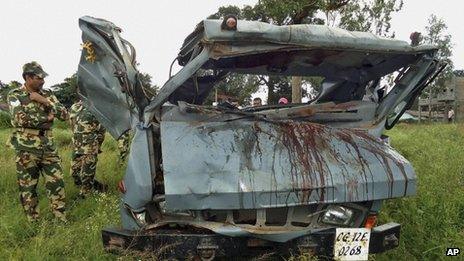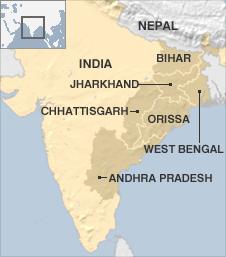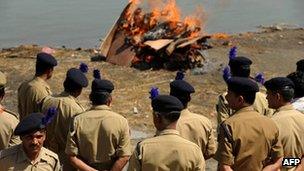Where the Maoist war is far from won
- Published

Security forces insist that fatalities in Maoist ambushes have reduced
More than six years since the launch of Salwa Judum, the government-sponsored anti-Maoist vigilante group and two years since Operation Green Hunt, the full-blown military offensive on Maoists, officials in the state of Chhattisgarh accept that the rebels have regrouped and consolidated their jungle base.
Central government figures suggest there has been a sharp dip in Maoist violence in 2011, compared to the past two years.
While this may be true of other states in India, in parts of Chhattisgarh, the epicentre of the Maoist movement, nothing can be further from the truth.
Here, according to police sources, the Maoists have raised new military forces from the local population.

In the past eight years, since various radical-left military factions decided to unite to form the Communist Party of India (Maoist), the number of Maoist military divisions here has risen from five to 10.
In Bastar district, in the south of Chhattisgarh, the Maoists recently launched a new division of the party called Mahasamund, named after a district on Bastar's eastern fringe and thus connecting Bastar with Maoist-affected districts in neighbouring Orissa.
Southern Chhattisgarh is an area just a little smaller than the Netherlands.
There are four zones dominated and governed by the Maoists here, each not less than 4,000 sq km in size.
One officer told me that the Maoists controlled 40% of the land area in southern Chhattisgarh, while the police controlled another 40%.
"The fighting is going on for control of the remaining 20%," he said.
If Maoist military activity such as ambushes has reduced here it is because the sides have cut their operations in the areas not under their control.
Retaliatory attacks by the Maoists have therefore also reduced.
In a month-long visit to one of these four "Maoist liberated zones" above the River Indravati I did not see any police camps or police personnel.
"We don't enter their areas, they don't come to ours," said one paramilitary soldier in Dantewada district.
The head constables of several police stations told the BBC that they received very little information about Maoist movement from the "kotwals", or village-level police personnel.
"The kotwals' families live in the villages and are exposed to the Maoists. So they refuse to divulge information," one head constable told me.
In the small, sleepy town of Dantewada, in southern Chhattisgarh, several people confirmed that Maoist cadres moved around in plainclothes, interacted with locals and ran errands for the party.
"I have never witnessed them so relaxed in the main town," said one local travel agent.
It could be because, locals feel, Maoists know that the police will never come out of their barracks at night.
'Carrot and stick'
So why is the Indian government's offensive going wrong here?
Its policy against the Maoists uses the anti-insurgent "carrot and stick" policy, using multiple development projects to win over locals.
This, combined with a sustained offensive to "neutralise" the top Maoist leadership and known sympathisers, worked very well in northern Andhra Pradesh, bordering southern Chhattisgarh.
Having now shifted across the state border into southern Chhattisgarh, the Maoists acknowledged that they had failed to address the developmental model introduced by the government.
In Chhattisgarh, they say they have fought back "politically" against the policy.
Jagesh, the chief of the northern regional command of the Maoist Party in Chhattisgarh, told the BBC last year: "The tribals are convinced that development is introduced to quash resistance and to take away land for mining. We have managed to impart this education."
Jagesh said that hundreds of boys from the local Gondi tribe, fearing displacement and police atrocities in the name of development, were joining them every year.

Security forces insist they will "turn it around" in southern Chhattisgarh
Large numbers of the boys have formed into "militias" or have become plainclothes Maoist informers and have made life difficult for the security forces.
Besides gathering information, these militias actively assist the Maoists' People's Liberation Guerrilla Army in combat by slowing down the security forces and preventing them reaching the rebels.
Indian security has so far failed to break up the ranks of the plainclothes tribal boys.
This, combined with increased Maoist forces here, have led to a series of setbacks for the security forces over the past couple of years.
Senior officials, however, told me that Maoists had won only "half the battle".
"We will turn it around," said one officer, before instructing his son not to go out of the house after five in the evening.
- Published7 March 2011